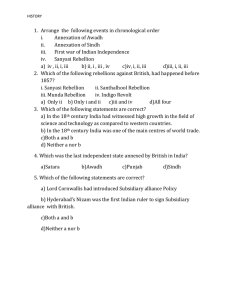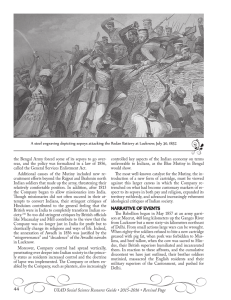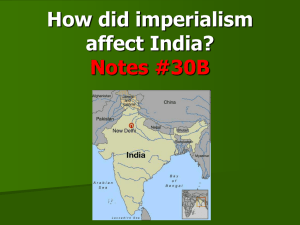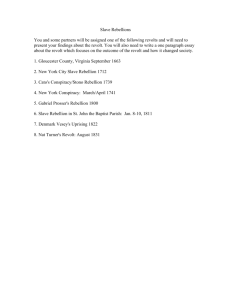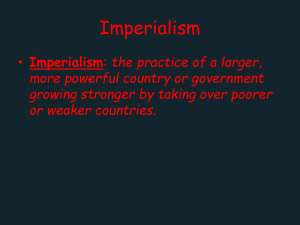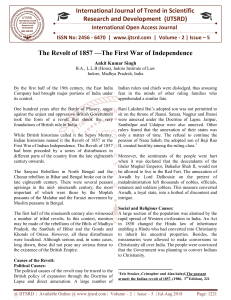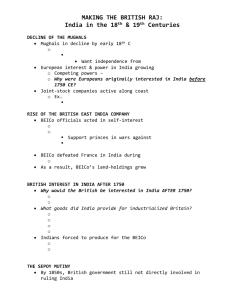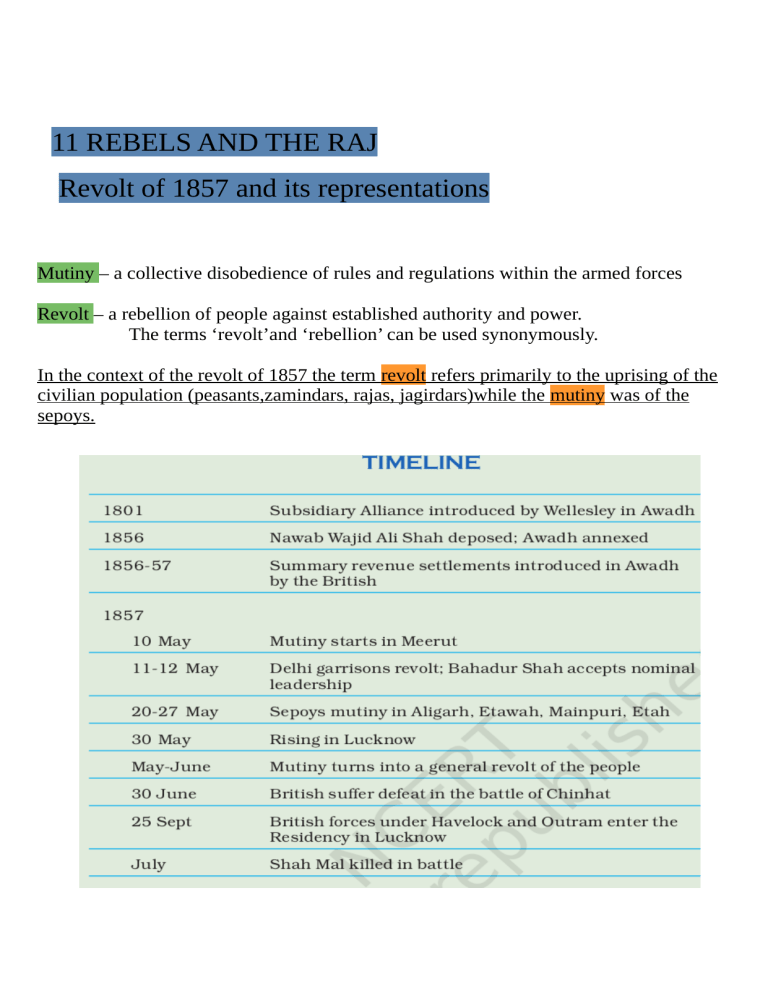
11 REBELS AND THE RAJ Revolt of 1857 and its representations Mutiny – a collective disobedience of rules and regulations within the armed forces Revolt – a rebellion of people against established authority and power. The terms ‘revolt’and ‘rebellion’ can be used synonymously. In the context of the revolt of 1857 the term revolt refers primarily to the uprising of the civilian population (peasants,zamindars, rajas, jagirdars)while the mutiny was of the sepoys. Basic Facts ➔ The revolt was started on 10th May of 1857 in the town of Meerut. ➔ It ended on 20 June 1858. ➔ The Revolt of 1857 is called ‘sepoy mutiny’ because it started by sepoys(Indian soldiers in British Indian Army) ➔ The revolt of 1857 is called ‘First war of Indian Independence’ ➔ Sepoys, Indian Native rulers(Princes),Peasants, common people participated ➔ The revolt of 1857 initiated by sepoys in the Bengal Presidency against the British officers. ➔ The first martyr of 1857 revolt was Mangal Pandey. ➔ He attacked his British sergeant on 29 March 1857 at Barrackpore. ➔ Lord canning was the governor general at that time ➔ The revolt of 1857 marked the end of rule by the British East India company. ➔ After this, in 1858, India was directly ruled by the British government through representatives called as Governor-General Centres of Revolt of 1857 and leaders Centre Leaders 1 Meerat Sepoys 2 Barrackpore(in present day West Bengal) Mangal Pandey 3 Delhi 1)Bahadur Shah II (last Mughal Emperor) 2)General Bakht Khan 4 Kanpur( in present day UP) 1)Nana Saheb, the adopted son of Baji Rao II and the last Peshwa 2)Tantia Tope 5 Lucknow ( in present day UP) Begam Hazrat Mahal(Begum of Awadh )(the wife of the Nawab Wajid Ali Shah) 6 Jhansi ( in present day UP) Rani Lakshmi Bai ( the widowed queen of Gangadhar Rao)joined by Tantia Tope 7 Arrah (Jagdispur )(in present day Bihar) Kunwar Singh Beginning of Revolt ➔ Late in the afternoon of 10 May 1857, the sepoys in the cantonment of Meerut broke out in mutiny. ➔ It began in the lines of the native infantry, spread very swiftly to the cavalry and then to the city. ➔ The ordinary people of the town and surrounding villages joined the sepoys. ➔ The sepoys captured the bell of arms (storeroom in which weapons are kept). ➔ They attacked white people, and burnt their bungalows and property. ➔ Government buildings – the record office, jail, court, post office, treasury, etc. – were destroyed and plundered. ➔ The telegraph line to Delhi was cut. ➔ The sepoys arrived at the gates of the Red Fort early in the morning on 11 May. ➔ They demanded that the emperor Bahadur Shah II give them his blessings. carried on in the name of the Mughal emperor ➔ Soon Bahadur Shah II became one of leaders of revolt Pattern of the Rebellion How the mutinies began ➔ The sepoys began their action with a signal: firing gun or sounding of the bugle. ➔ They first seized the bell of arms and plundered the treasury. ➔ They then attacked government buildings – the jail, treasury, telegraph office, record room, bungalows – burning all records. ➔ Everything and everybody connected with the white man became a target. ➔ Proclamations were issued in Hindi, Urdu and Persian ➔ Called upon the population, both Hindus and Muslims, to unite, rise and exterminate the firangis (foreigners) ➔ Money-lenders and the rich also were attacked ➔ Individual Britons tried to save their own lives and the lives of their families. ➔ One British officer noted,“British rule collapsed like a house made of cards’’ ➔ Reports from different cities tell us about the breakdown in routine activities. Like reports from the Delhi Urdu Akhbar Lines of communication planning and coordination of revolt ➔ There was communication between the sepoy lines of various cantonments. ➔ After the 7th Awadh Irregular Cavalry had refused to accept the new cartridges in early May, they wrote to the 48th Native Infantry that “they had acted for the faith and awaited the 48th’s orders”. ➔ Sepoys or their emissaries moved from one station to another. ➔ People were thus planning and talking about the rebellion. ➔ Charles Ball, historian, noted that panchayats or meetings arranged at the nightin the Kanpur sepoy lines Example of planning and communication 1 ➔ Captain Hearsey of the Awadh Military Police had been given protection by his Indian subordinates. ➔ The 41st Native Infantry, insisted that the Military Police should also kill Hearsey or deliver him as prisoner to the 41st. ➔ The Military Police refused and it was decided that the matter would be settled by a panchayat composed of native officers drawn from each regiment. ➔ What this suggests is that some of the decisions were taken collectively. Example of planning and communication 2 ➔ François Sisten was a native Christian police inspector in Sitapur(UP) ➔ He had gone to Saharanpur to pay his respects to the magistrate. ➔ Sisten was dressed in Indian clothes and sitting cross-legged. ➔ A Muslim tahsildar from Bijnor entered the room; upon learning that Sisten was from Awadh, he enquired, “What news from Awadh? How does the work progress, brother?” ➔ Playing safe, Sisten replied, “If we have work in Awadh, your highness will know it.” ➔ The tahsildar said, “Depend upon it, we will succeed this time. The direction of the business is in able hands.” ➔ The tahsildar was later identified as the principal rebel leader of Bijnor (Here The tahsildar regarded Sisten as a potential rebel) Leaders and followers Who were leaders and followers of the revolt? Ranis, Rajas, Nawabs,Taluqdars, Zamindars Peasants, Tribal, Ordinary men and women, Religious men Bahadur Shah II ➔ Bahadur shah II was nominal Mughal emperor during the revolt ➔ He was old and not ready to become leader ➔ He was in Mughal court within the Red Fort ,Delhi ➔ later he agreed to be the nominal leader of the rebellion. Nana Sahib ➔ In Kanpur, the sepoys and the people of the town made Nana Sahib, the successor to Peshwa Baji Rao II, as their leader. ➔ At the end of 1858, when the rebellion collapsed, Nana Sahib escaped to Nepal Rani Lakshmi Bai ➔ In Jhansi, the rani was forced by the popular pressure around her to assume the leadership of the uprising. Kunwar Singh ➔ Kunwar Singh was, a local zamindar in Arrah in Bihar took leadership by the popular pressure Birjis Qadr ➔ In Awadh, (Lucknow )British displaced the popular Nawab Wajid Ali Shah and the annexed of the state to British India ➔ During the revolt the people in Lucknow celebrated the fall of British rule by hailing Birjis Qadr, the young son of the Nawab, as their leader. Fakir(religious leader) ➔ From Meerut, there were reports that a fakir had appeared riding on an elephant and that the sepoys were visiting him frequently. ➔ local leaders emerged, urging peasants, zamindars and tribals to revolt. Gonoo ➔ Gonoo, a tribal cultivator of Singhbhum in Chotanagpur, became a rebel leader of the Kol tribals of the region. Shah Mal ➔ Shah Mal was one of the leader of the revolt 1857 ➔ Shah Mal lived in a large village in pargana Barout in Uttar Pradesh. ➔ He belonged to a clan of Jat cultivators whose kinship ties extended over chaurasee des (eighty-four villages). ➔ The lands were irrigated and fertile, with rich dark loam soil. ➔ villagers saw the British land revenue system as oppressive ➔ Consequently cultivators were losing land to outsiders, to traders and money lenders who were coming into the area. ➔ Shah Mal mobilised the headmen and cultivators of chaurasee des, moving at night from village to village, urging people to rebel against the British. ➔ Cultivators left their fields and plundered the houses of moneylenders and traders. ➔ Displaced proprietors took possession of the lands they had lost. ➔ Shah Mal’s men attacked government buildings, destroyed the bridge over the river, and dug up metalled roads ➔ They sent supplies to the sepoys who had mutinied in Delhi ➔ Locally acknowledged as the Raja, Shah Mal took over the bungalow of an English officer, turned it into a “hall of justice”, settling disputes and dispensing judgments. ➔ He also set up an amazingly effective network of intelligence. ➔ Shah Mal was killed in battle in July 1857. Maulvi Ahmadullah Shah ➔ Maulvi Ahmadullah Shah was one of the many maulvis who played an important part in the revolt of 1857. ➔ Educated in Hyderabad, he became a preacher when young. ➔ In 1856, he was seen moving from village to village preaching jehad (religious war) against the British and urging people to rebel. ➔ He moved in a palanquin, with drumbeaters in front and followers at the rear. ➔ He was therefore popularly called Danka Shah – the maulvi with the drum ( danka ). ➔ British officials panicked as thousands began following the maulvi and many Muslims began seeing him as an inspired prophet. ➔ When he reached Lucknow in 1856, he was stopped by the police from preaching in the city. ➔ Subsequently, in 1857, he was jailed in Faizabad. ➔ When released, he was elected by the mutinous 22 nd Native Infantry as their leader. ➔ He fought in the famous Battle of Chinhat in which the British forces under Henry Lawrence were defeated. ➔ He was killed in 1858 Henry Hardinge, As Governor General, Hardinge attempted to modernise the equipment of the army. The Enfield rifles that were introduced initially used the greased cartridges the sepoys rebelled against Rumours and prophecies Roumor 1 bullets coated with the fat of cows and pigs British introduced the new 'Enfield' rifle in the army. The cartridge had to be bitten off before loading it into the gun. Muslims had a belief that the cartridge was greased with pig fat where Hindus believed the grease was made from cow fat. Roumor 2 the British had mixed the bone dust of cows and pigs into the flour that was sold in the market By this the British government had conspiracy to destroy the caste and religion of Hindus and Muslims Roumor 3 The British wanted to convert Indians to Christianity prophecies 1 The prophecy that British rule would come to an end on the centenary of the Battle of Plassey, on 23 June 1857 2 Chapatti distribution Reports came from various parts of North India that chapattis were being distributed from village to village. A person would come at night and give a chapatti to the watchman of the village and ask him to make five more and distribute to the next village, and so on. The meaning and purpose of the distribution of the chapattis was not clear and is not clear people read it as an omen of an upheaval. Origin of The rumour that the cartridges were greased with the fat of cows and pigs ➔ Captain Wright, commandant of the Rifle Instruction Depot, reported that in the third week of January 1857 a “low-caste” khalasi who worked in the magazine in Dum Dum had asked a Brahmin sepoy for a drink of water from his lota. ➔ The sepoy had refused saying that the “lower caste’s” touch would defile the lota. ➔ The khalasi had reportedly retorted, “You will soon lose your caste, as ere long you will have to bite cartridges covered with the fat of cows and pigs.” ➔ We do not know the veracity of the report, but once this rumour started British officers could not stop its circulation Why did people believe in the rumours? ➔ Rumours circulate only when they resonate with the deeper fears and suspicions of people. ➔ 1 Reformation policies The policies the British pursued from the late 1820s under the leadership of Governor General Lord William Bentinck The British adopted policies aimed at “reforming” Indian society by introducing Western education, Western ideas and Western institutions, set up Englishmedium schools, colleges and universities which taught Western sciences and the liberal arts, abolished customs like sati (1829) and to permitted the remarriage of Hindu widows. 2 Annexation of native states; The British annexed not only Awadh, but many other kingdoms and principalities like Jhansi and Satara. 3 the activities of Christian missionaries. Subsidiary Alliance System ➔ Subsidiary Alliance was a system devised by Lord Wellesley in 1798. ➔ All those who entered into such an alliance with the British had to accept certain terms and conditions: (a) The British would be responsible for protecting their ally from external and internal threats to their power. (b) In the territory of the ally, a British armed contingent would be stationed. (c) The ally would have to provide the resources for maintaining this contingent. (d) The ally could enter into agreements with other rulers or engage in warfare only with the permission of the British. Resident was the designation of a representative of the Governor General who lived in a state which was not under direct British rule. Awadh in Revolt “A cherry that will drop into our mouth one day” 1 Why British annexed Awadh? ➔ In 1851 Governor General Lord Dalhousie described the kingdom of Awadh as “a cherry that will drop into our mouth one day”. ➔ Five years later, in 1856, the kingdom was formally annexed to the British Empire. ➔ The Subsidiary Alliance had been imposed on Awadh in 1801. ➔ British Resident stationed at Awadh ➔ the British became increasingly interested in acquiring the territory of Awadh. ➔ They felt that the soil there was good for producing indigo and cotton ➔ By the early 1850s, moreover, all the major areas of India had been conquered: the Maratha lands, the Doab, the Carnatic, the Punjab and Bengal. ➔ The takeover of Awadh in 1856 was expected to complete a process of territorial annexation The life was gone out of the body” 2 How people responded annexation of Awadh? ➔ Lord Dalhousie’s annexations created disaffection in all the areas and principalities that were annexed ➔ In Awadh Nawab Wajid Ali Shah was dethroned and exiled to Calcutta on the plea that the region was being misgoverned. ➔ Nawab Wajid Ali Shah was widely loved, and when he left his beloved Lucknow, there were many who followed him all the way to Kanpur singing songs of lament ➔ The widespread sense of grief and loss at the Nawab’s exile was recorded by many contemporary observers. ➔ One of them wrote: “The life was gone out of the body, and the body of this town had been left lifeless ... there was no street or market and house which did not wail out the cry of agony in separation of Jan-i-Alam.” ➔ Another song mourned the plight of the ruler who had to leave his motherland: ‘’Noble and peasant all wept together and all the world wept and wailed Alas! The chief has bidden adieu to his country and gone abroad’’ ➔ One folk song bemoaned that “the honourable English came and took the country’ (Angrez Bahadur ain, mulk lai linho ). ➔ The removal of the Nawab led to the dissolution of the court and Musicians, dancers, poets, artisans, cooks, retainers, administrative officials and so on – lost their livelihood Firangi raj and the end of a world 3 What were the results of annexation of Awadh? ➔ A chain of grievances in Awadh linked prince, taluqdar, peasant and sepoy. ➔ In different ways they came to identify firangi raj with the end of their world – the breakdown of things they valued, respected and held dear. ➔ A whole complex of emotions and issues, traditions and loyalties worked themselves out in the revolt of 1857. ➔ In Awadh, annexation dispossessed the taluqdars of the region. What happened to taluqdars after the annexation of Awadh? ➔ The countryside of Awadh was dotted with the estates and forts of taluqdars who for many generations had controlled land and power in the countryside. ➔ Before the coming of the British, taluqdars maintained armed retainers, built forts, and enjoyed a degree of autonomy, as long as they accepted the suzerainty of the Nawab and paid the revenue of their taluqs. ➔ Some of the bigger taluqdars had as many as 12,000 foot- soldiers and even the smaller ones had about 200. ➔ Immediately after the annexation, the taluqdars were disarmed and their forts destroyed. ➔ After annexation, the first British revenue settlement, known as the Summary Settlement of 1856, t proceeded to remove the taluqdars wherever possible. ➔ The dispossession of taluqdars meant the breakdown of an entire social order. The ties of loyalty and patronage that had bound the peasant to the taluqdar were disrupted. ➔ In pre-British times, the taluqdars were oppressors but many of them also appeared to be generous father figures: they exacted a variety of dues from the peasant but were often considerate in times of need ➔ Taluqdars were loyal to the Nawab of Awadh, and they joined Begum Hazrat Mahal (the wife of the Nawab Wajid Ali Shah ) in Lucknow to fight the British; some even remained with her in defeat. The grievances of the sepoys ➔ The sepoys received low levels of pay and the difficulty of getting leave ➔ In the 1820s, white officers made it a point to maintain friendly relations with the sepoys. ➔ In the 1840s, officers developed a sense of superiority and started treating the sepoys as their racial inferiors ➔ Abuse and physical violence became common and thus the distance between sepoys and officers grew. The link between the sepoys and the rural world ➔ The large majority of the sepoys of the Bengal Army were recruited from the villages of Awadh and eastern Uttar Pradesh. ➔ Many of them were Brahmins or from the “upper” castes. ➔ Awadh was called the “nursery of the Bengal Army’’. ➔ The changes that the families of the sepoys saw around them and the threats they perceived were quickly transmitted to the sepoy lines. ➔ In turn, the fears of the sepoys about the new cartridge, their grievances about leave, their grouse about the increasing misbehaviour and racial abuse on the part of their white officers were communicated back to the villages. What the Rebels Wanted? 1 Rebels wanted to restore the pre-British Hindu-Muslim past 2 Rebels wanted to establish a more egalitarian society. 3 Rebels wanted to restore the pre-British political order of the18th century 1 The vision of unity Rebels wanted to restore the pre-British Hindu-Muslim past ➔ The rebel proclamations in 1857 repeatedly appealed to all sections of the population, irrespective of their caste and creed. ➔ Many of the proclamations were issued by Muslim princes or in their names but even these took care to address the sentiments of Hindus. ➔ The rebellion was seen as a war in which both Hindus and Muslims had equally to lose or gain. ➔ The ishtahars harked back to the pre-British Hindu-Muslim past and glorified the coexistence of different communities under the Mughal Empire. ➔ The proclamation that was issued under the name of Bahadur Shah appealed to the people to join the fight under the standards of both Muhammad and Mahavir. ➔ It was remarkable that during the uprising religious divisions between Hindus and Muslim were hardly noticeable despite British attempts to create such divisions. ➔ In Bareilly in western Uttar Pradesh, in December 1857, the British spent Rs 50,000 to incite the Hindu population against the Muslims. The attempt failed. 2 Against the symbols of oppression Rebels wanted to establish a more egalitarian society. ➔ The proclamations completely rejected everything associated with British rule or firangi raj ➔ What enraged the people was how British land revenue settlements had dispossessed landholders, both big and small, and foreign commerce had driven artisans and weavers to ruin. ➔ People were urged to come together and fight to save their livelihood, their faith, their honour, their identity – a fight which was for the “greater public good”. ➔ In many places the rebellion against the British widened into an attack on all those who were seen as allies of the British or local oppressors. ➔ The rebels deliberately sought to humiliate the elites of a city. ➔ In the villages they burnt account books and ransacked moneylenders’ houses. ➔ It presents a glimpse of an alternative vision, perhaps of a more egalitarian society. 3 The search for alternative power Rebels wanted to restore the pre-British political order of the eighteenth century ➔ Once British rule had collapsed, the rebels in places like Delhi, Lucknow and Kanpur tried to establish some kind of structure of authority and administration. ➔ The rebel leadership wanted to restore the pre-British world of the eighteenth century. ➔ The leaders went back to the culture of the court( culture back to the eighteenth-century Mughal world). ➔ The administrative structures established by the rebels were primarily aimed at meeting the demands of war. ➔ In Awadh, plans of counter-attack by the Lucknow court were in place as late as the last months of 1857 and the early part of 1858. Repression of the revolt How the revolt was repressed by British? 1 legal measures ➔ By a number of Acts, passed in May and June 1857 whole of North India put under martial law ➔ Military officers and even ordinary Britons were given the power to try and punish Indians suspected of rebellion. ➔ The ordinary processes of law and trial were suspended and it was put out that rebellion would have only one punishment – death. 2 Military actions ➔ One force moved from Calcutta into North India and the other from the Punjab – to reconquer Delhi. ➔ British attempts to recover Delhi began in earnest in early June 1857 but it was only in late September that the city was finally captured. ➔ In the Ganegtic plain too the progress of British reconquest was slow. The forces had to reconquer the area village by village. ➔ In Awadh, a British official called Forsyth estimated that three-fourths of the adult male population was in rebellion. (The area was brought under control only in March 1858 after protracted fighting) ➔ The British used military power on a gigantic scale. 3 Diplomatic Measures ➔ The British tried to break up the unity by promising to give back to the big landholders their estates. ➔ Rebel landholders were dispossessed and the loyal rewarded ➔ Many landholders died fighting the British or they escaped into Nepal where they died of illness or starvation. Images of the Revolt Pictorial images produced by the British and Indians: paintings, pencil drawings, etchings, posters, cartoons and bazaar prints There are two types of stories and images related to revolt of 1857 1)The stories and images spread by British through their media in Britain 2)The Indian nationalist imageries How British media presented the revolt? 1) The stories of the revolt published in British newspapers and magazines inflamed public feelings and provoked demands of retribution and revenge. 2) Some images created a sense that the time of trouble was past and the rebellion was over; the British were the victors. 3) Some images showed rebels violence against women and children and to provoked British people for revenge 4) Images show the honour of English women is in danger 5) Images depicted British rescue forces as saviours 6) Images depicted the rebels as violent and brutish 7) Images show repression as a battle to save Christianity 8) Images of brutal repression 9) Images of brutal executions were widely circulated to create terror among Indians 10) At a time of British revenge,moderate policies were ridiculed in the images 1 Celebrating the saviours Image no.1 ‘’ Relief of Lucknow’’ painted by Thomas Jones Barker in 1859 see the image in the text book ➔ When the rebel forces besieged Lucknow, Henry Lawrence, the Commissioner of Lucknow, collected the Christian population and took refuge in the heavily fortified Residency. ➔ Lawrence was killed but the Residency continued to be defended under the command of Colonel Inglis. ➔ On 25 September James Outram and Henry Havelock arrived, cut through the rebel forces, and reinforced the British garrisons. ➔ Twenty days later Colin Campbell, who was appointed as the new Commander of British forces in India, came with his forces and rescued the besieged British garrison. ➔ In British accounts the siege of Lucknow became a story of survival, heroic resistance and the ultimate triumph of British power. ➔ Barker’s painting celebrates the moment of Campbell’s entry. ➔ At the centre of the canvas are the British heroes – Campbell, Outram and Havelock. ➔ The gestures of the hands of those around lead the spectator’s eyes towards the centre. ➔ The heroes stand on a ground that is well lit, with shadows in the foreground and the damaged Residency in the background. ➔ The dead and injured in the foreground are testimony to the suffering during the siege, while the triumphant figures of horses in the middle ground emphasise the fact that British power and control had been re-established. ➔ To the British public such paintings were reassuring. ➔ They created a sense that the time of trouble was past and the rebellion was over; the British were the victors English women and the honour of Britain Image No 2 “In Memoriam” painted by Joseph Noel Paton see the image in the text book ➔ “In Memoriam” was painted by Joseph Noel Paton two years after the mutiny. ➔ In this image English women and children huddled in a circle, looking helpless and innocent, seemingly waiting for the inevitable – dishonour, violence and death. ➔ It represents the rebels as violent and brutish, even though they remain invisible in the picture. ➔ In the background you can see the British rescue forces arriving as saviours. Image no.3 Miss Wheeler defending herself against sepoys in Kanpur see the image in the text book ➔ Miss Wheeler stands firmly at the centre, defending her honour, single-handedly killing the attacking rebels. ➔ Here, four burly males with swords and guns are shown attacking a woman. ➔ It is represented as having a deeper religious connotation: it is a battle to save the honour of Christianity,the book lying on the floor is the Bible. Vengeance and retribution Image No.4 ‘’justice’’published by Punch magazine ➔ An allegorical female figure of justice with a sword in one hand and a shield in the other. ➔ Her posture is aggressive; her face expresses rage and the desire for revenge. ➔ She is trampling sepoys under her feet while a mass of Indian women with children cower with fear. The performance of terror Image no.5 Execution of mutineers in Peshawar: Blowing from the guns, Illustrated London News,3 October 1857 Image no.6 Execution of mutinous sepoys in Peshawar, Illustrated London News, 3 October 1857 see text for images ➔ The urge for vengeance and retribution was expressed in the brutal way in which the rebels were executed. ➔ They were blown from guns, or hanged from the gallows. ➔ Images of these executions were widely circulated through popular journals. No time for clemency Image No.7 ‘The Clemency of Canning’, Punch, 24 October 1857 ➔ Lord Canning was governor general ➔ He was criticised and ridiculed by some British media for showing mercy to sepoys ➔ In one of the cartoons published in the pages of Punch, a British journal of comic satire, Canning is shown as a looming father figure, with his protective hand over the head of a sepoy who still holds an unsheathed sword in one hand and a dagger in the other, both dripping with blood Nationalist imageries of the revolt ➔ The revolt celebrated as the First War of Independence by Indian nationalists ➔ The leaders of the revolt were presented as heroic figures ➔ The leaders are presented as freedom fighters against oppressive imperial rule. ➔ Heroic poems were written about the valour of the queen who, with a sword in one hand and the reins of her horse in the other, fought for the freedom of her motherland. ➔ Rani of Jhansi was represented as a masculine figure chasing the enemy, slaying British soldiers and valiantly fighting till her last. ➔ Children in many parts of India grow up reading the lines of Subhadra Kumari Chauhan: “Khoob lari mardani woh to Jhansi wali rani thi” (Like a man she fought, she was the Rani of Jhansi). ➔ In popular prints Rani Lakshmi Bai is usually portrayed in battle armour, with a sword in hand and riding a horse – a symbol of the determination to resist injustice and alien rule.
